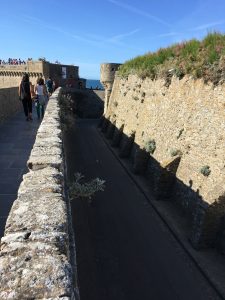I will admit that the reason I chose to stay in St Malo for the next 3 days is solely because of the book “All The Light we Cannot See”. It’s the intersecting stories of a young blind French Girl and a German soldier during the occupation of France in the 1940’s, and the description of the town had me, even as it was described during wartime. So, I had little knowledge of St Malo except that it is close enough to Mont St Michel to make that excursion feasible. And I have been so pleasantly surprised by this seaside town.
Saint-Malo was named for Maclou, or Malo, a Welsh monk who fled to Brittany, making his headquarters on the island, in the 6th century and probably became the first bishop of Aleth (Saint-Servan). The island was not substantially inhabited until the 8th century, when the population of the surrounding district sought refuge there from the Normans. In the 17th and 18th centuries, Saint-Malo derived prosperity from its navigators, traders, and privateers. The corsairs of the 17th/18th centuries acted as official pirates. The King of France granted them licence to go “coursing” after enemy vessels in return for a percentage of the profit from captured ships, hence the name corsairs. The town was three-fourths destroyed during World War II, but it has been rebuilt. The ramparts that surround the Intramuros, or old town, still stand and provide a seaside walk around it. The large residential homes have been rebuilt in the same style that existed before the war, so the entire area has the sense of a place out of time.
There are several islands offshore what house the remnants of old forts which are only available at low tide. As I started my walk this morning I noted that the path seemed accessible, but not knowing whether the tide was going in or out I hurried to make the trek to Grand Be island. Turned out the tide was just beginning to go out, so by the time I headed back the walkway wasn’t even necessary because the tide was so low. By this evening you couldn’t even see the walkway! The tidal range is at least 1.4km! And at last it was a sunny and warm (ish) day, so I spent some time on the beach, reading my book and watching how the French vacation. Also of note is the piscine de bon secours — a salt water pool built into the beach, which stays full during low tide and almost disappears, except for the diving board when the tide is high. The water is too cold for me, but the French frolicked freely!
I couldn’t pass up a stop at the Cathedral. It’s a typical one, dedicated to Saint Vincent, and has been built, re-built, enlarged and repaired over the centuries dating from the 13th-18th. The burial place of the man who discovered Canada, Jacques Cartier is here. The spire was destroyed in the battle to liberate the city in August, 1944, and has since been replaced.
There are many tourists, as St Malo has become the most visited place in all of Brittany, which explains the traffic yesterday. The area is known for crepes and Breton striped shirts which are evident in every shop. The St Malo of today isn’t steeped in the history of WWII, so the connection to the book that brought me here isn’t evident. But it’s lovely and perfect just the same.














